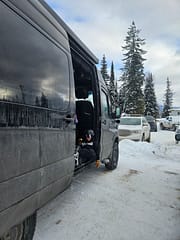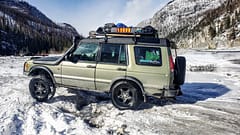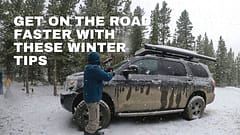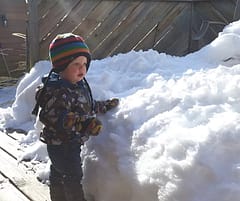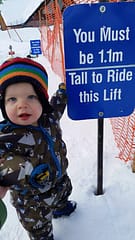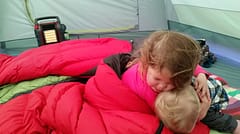Winter Van Life in Our 2015 Mercedes-Benz Sprinter 4x4
A Family Adventure in Canada’s Mountains
Contents
- Introduction
- What We Consider The Essentials for a Winter Setup
- Gearing Up for the Unexpected - The Safety Stuff
- The Good and the Challenges
- The Reality: It’s Not Summer Camping
Introduction
Picture this: the snow is falling gently outside, the kids are giggling over mugs of hot chocolate playing, and the hum of our diesel heater fills the air with warmth while simultaneously drying our wet gloves. It’s a crisp -20°C night in the Canadian mountains and our family of four; two adults and our 9 and 11 year old adventurers are tucked into our 2015 Mercedes-Benz Sprinter Van 4x4 for a winter overnight. For us, this van isn’t just a vehicle it’s our ticket to ski trips, spontaneous explorations, and memories that stick with you long after the snow melts. Winter camping has become a beloved part of our off-road lifestyle, but let me tell you it’s not like pitching a tent in July. It’s colder, it’s wetter, it’s challenging, and it’s absolutely worth it. Here’s our story, complete with the gear that keeps us going and the hiccups we’ve learned to navigate, to inspire you to give it a shot yourself.

What We Consider The Essentials for a Winter Setup
Our Sprinter is a 2015 4x4 144inch wheel base and it is a rugged beast that’s carried us through snowy backroads and icy resort parking lots alike. With two adults and two kids, space is at a premium, but we’ve dialed in the essentials to make it work. Let’s just jump into one of our favorite add-ons for winter and summer alike. Our Van Essential insulated window covers. These aren’t just a nice to have item, they’re a game changer! In winter, they trap heat inside, making the van feel like a cozy cocoon even when the wind is howling outside. (Pro tip: they’re just as clutch in summer to keep the heat out.) They also black out the windows, giving us privacy and letting us sleep past the early mountain sunrise—because no one wants to be woken up by blinding light. They sell them custom fit for the Sprinters, and trust me, the difference in temperature is night and day. Cover all the windows!
Having a heater in the winter is non-negotiable. We rely on a Wayska diesel heater from Amazon.ca, a budget-friendly gem. Hooked up to the van’s fuel tank, it pumps out serious heat! It’s been reliable through countless trips, sipping diesel efficiently while keeping us toasty.
If you have solar and no ladder get a long handled broom to sweep snow off the windows and our solar panel. We bought a step attachment for the slidding door to stand on to reach the roof, also a cheap Amazon find.
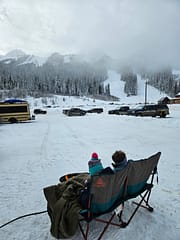
Gearing Up for the Unexpected - The Safety Stuff
Winter in the mountains doesn’t mess around, so we pack for the worst. Our Maxx Tracks are our go to recovery gear. They are lightweight, durable boards that give the Sprinter’s 4x4 system an extra edge when the snow gets deep or the ice gets slick. We’ve never had to use them in a dire situation (in the Sprinter, but we have used them with other vehicles), but they’re peace of mind. They do take up space so if you figure out an outside solution go for it, we haven’t done that yet.
For real emergencies, our Garmin inReach is a lifeline. Out here, cell service is unreliable, but this little device lets us send an SOS or text home if things go sideways. Once you purchase the device it’s about $20/month to have hooked up, but when you’re miles from nowhere with kids in tow, it’s worth every penny. And yes we have used it many times to keep in touch in backcountry situations as well as one emergency (not related to the van but our buddy getting helicoptered from a mountain side bike injury sure appreciated it).
The Good and the Challenges
Inside, a kettle is our MVP for quick comfort. It’s electric, so it draws power from our battery setup, but there’s nothing like boiling water in minutes for soup, coffee, or the kids’ hot chocolate. Speaking of power, we run an EcoFlow Delta 2000, a 2000-watt beast that keeps everything humming, but here’s the catch: lithium batteries like this one need to stay above 0°C to charge properly. At -20°C, it’s a struggle! We’ve got a heating pad for it, but below -10°C, it can’t keep up. Sometimes we bring the battery inside the house to charge before a trip and if we’re out overnight it cools down while we’re skiing or exploring. Then it’s a waiting game to warm it back up. We’ve toyed with ideas like a small insulated battery box with a beefier heating solution, but for now, it’s a quirk we work around.
Water’s another challenge. We use a blue water jug with a white turn valve, it is simple and effective until it freezes. At -10°C or colder the water often gets icy and if we forget to tip it upright vs down to use the valve the valve ices up. We try to keep our water bottles full as they tend to be in bags and don’t freeze. Water freezing is a challenge we haven’t figure out yet, we have always been able to take off the vavle and pour from the big opening so it is annoying but not stopping us from water access.
Our floor is not insulated and we don’t think loosing the space in the height of the van is worth it. Down booties and some simple floor mats are our secret weapon for keeping our feet warm. The Sprinter’s floor gets frigid and mats and booties insulate you from it perfectly.
The Reality: It’s Not Summer Camping
If you’re reading this and thinking, “That sounds intense,” you’re not wrong. But it’s also magic. There’s something primal about thriving in the cold, about turning a van into a home when the world outside is frozen solid. You don’t need a fancy rig, our 2015 Sprinter’s a workhorse, not a showpiece, but you do need the right gear and a willingness to roll with the punches. Start small like an overnight near a ski hill. Test your setup, see what works. Those insulated window covers? Get them. A diesel heater? Do it. Recovery gear and an inReach? Smart moves. And don’t skimp on the hot chocolate, it’s the glue that holds it all together.
We’ve learned a ton along the way, and we’re still tweaking things like finding a better way to keep that EcoFlow warm or thawing out that pesky water valve. But every trip is a story, and every story makes us love this lifestyle more. So grab your crew, pile into your van and give winter camping a shot. It’s not summer and that’s exactly why it’s awesome.
